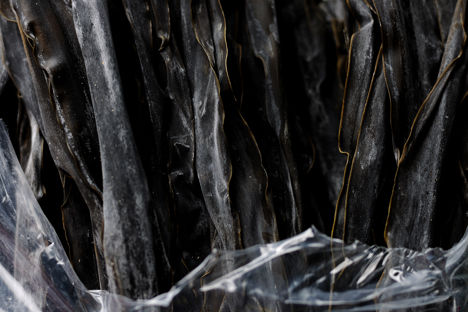Dashi is to Japanese cuisine what chicken stock is to French cuisine. It is clearer and thinner than stocks used in Western cuisines, with a distinct saltiness and umami-rich, flavour of the sea which underpin a lot of the country's national dishes. Dashi can be made fresh, but instant granules are a key ingredient in the Japanese cook's arsenal, as the stock is often used as the base of soups or dipping sauces.
Traditionally, families made their own dashi at home. To do this, a big pan of water is brought to the boil. Dried kombu seaweed, and dried bonito (fish) flakes are then steeped in the gently simmering water, and strained. As with tea leaves, the dried seaweed and fish flakes can be reused — but will create a weaker 'brew'. The stronger, first-brew dashi is known as ichiban dashi, and the second, weaker brew is called niban dashi.
The downfalls when it comes to making dashi from scratch are the cost of bonito flakes and the time investment means that it's often cheaper and more efficient to use instant dashi granules. Instant dashi is often sold in 5g sachets, which can be torn open and stirred into hot water - as with powdered stock. The granules can also be bought in larger pots, and occasionally in pre-mixed sachets of liquid stock. These can be found in some large supermarkets, as well as Japanese speciality food shops.
How to cook with dashi
Dashi is most commonly used as the base of a broth. To do so, add instant granules to a pan of hot water and stir until they have dissolved - as with a stock cube - or fill the pan with hot, homemade dashi. Next, stir in other flavourings like soy, mirin, sake or miso. Finally, cook the more substantial soup ingredients like tofu or vegetables in the flavoured dashi.
Adding a pinch of dashi granules, or a splash of ready-mixed dashi is a way of introducing umami-rich, Japanese flavours to traditional recipes. The technique is used in okonomiyaki or takoyaki batters, and the pre-mixed stock can even be set into a dashi jelly or used in a savoury sorbet.
What dashi goes with
The bonito fish flavours and umami-rich seaweed makes dashi a natural partner to fish. But dashi is different to a fish stock - while a fish stock echoes fish-flavours, dashi picks out and highlights more subtle sea-salt aspects. Dashi works well with shellfish too, as demonstrated by Simon Hulstone's dashi sorbet with brown crab or the dashi-onion broth which David Everitt-Matthias uses to accompany scallops
When using dashi, it's best to think of it in the context of other Japanese ingredients. Look to soy or miso rather than salt, mirin for sweetness, and everything from wakame to salmon and aubergine, as natural partners.
Get in touch
Please sign in or register to send a comment to Great British Chefs.



